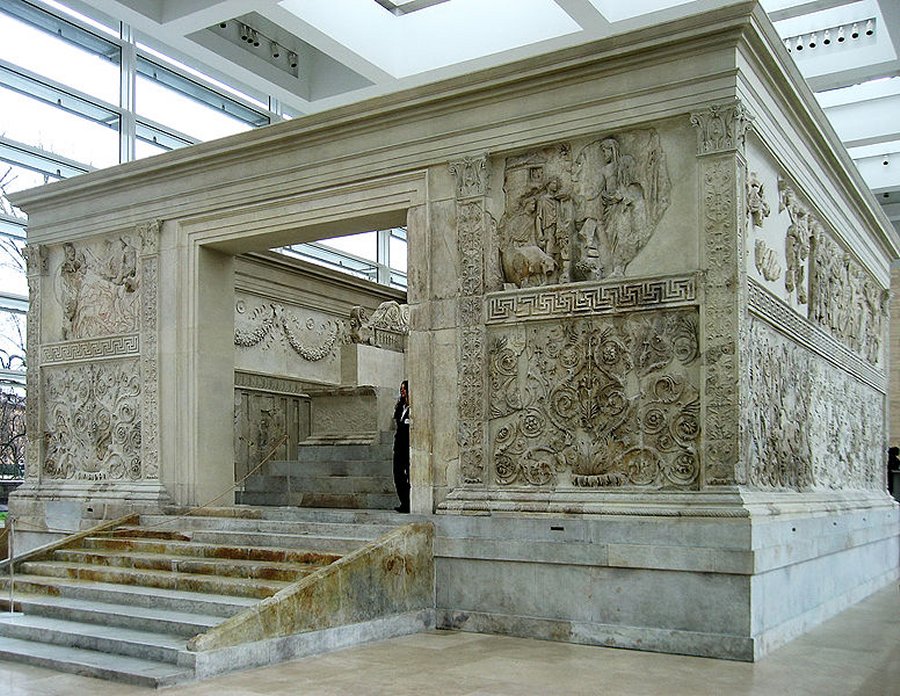Dark And Light Sides Of Pax Romana: Great Political Slogan Introduced After Civil Wars
A. Sutherland - AncientPages.com - The Pax Romana ("Roman Peace") was a political slogan of great importance. It was introduced after the civil wars but not immediately after the Battle of Actium in 31 BC.
 The map depicts the Roman Empire in 117 C.E., at the height of the Pax Romana. Image credit: ushistory.org
The map depicts the Roman Empire in 117 C.E., at the height of the Pax Romana. Image credit: ushistory.org
The "Roman Peace" was delayed and could start in 27 BC. The continued fighting occurred in Hispania (the Roman name for the Iberian Peninsula) and the Alps region. It ended when Emperor Marcus Aurelius died in 180 CE.
The Empire, which during the first and second centuries AD had a considerable territorial extent, was prosperous and peaceful. Its power was stable, military expansion of Rome was limited to a minimum, warfare was banished to the frontiers protected by the army, and the war was banished.
During the Pax Romana, the Empire was inhabited by approx. 70 million people.
Monuments of the Empire's prosperity, such as influential buildings, aqueducts that survived to modern times, roads, and archaeological finds, show the people's technical skills in the Roman Empire.
The Pax Romana contributed to the Empire's prosperity; it was a time, when the army and warfare protected the frontiers were banished. The Roman roads were full of merchants and traders on their way to new markets. Rome traded with the Han Dynasty through the Silk Road, and economic expansion increased the Empire's wealth through taxes and duties.
This first Roman Emperor Augustus proved to be an effective leader. The image depicts Augustus in a victory pose. Possibly on the occasion of the Battle of Actium. Image's current location: Chiaramonti Museum, Braccio Nuovo (New Wing); credit: Till Niermann - Public Domain
But another aspect also cast a negative light on this crucial historical era and the popularity of Rome. We can mention the cruelty of mass slavery, extremely brutal gladiatorial entertainments, and plenty of practices of evil (even mad) emperors such as mentally unstable Caligula, the Roman emperor in 37 AD who declared himself a god.
Eventually, Caligula's bizarre and cruel behavior resulted in his assassination by his guards only a few years later, in 41 AD. Another evil tyrant and controversial emperor during Pax Romana was Nero. He misused his political power, had his mother killed, and executed many Christians and all people who disagreed with him. This infamous ruler committed suicide in 68 AD.
Some "good Emperors" born outside Rome were Nerva, Trajan, Hadrian, Antoninus Pius, and Marcus Aurelius, who expanded Rome's borders and better controlled distant parts of the Empire.
The era of the Pax Romana did not change conditions for poor people who lived in poverty, despite all of the wealth of the Roman Empire. There was a vast gap between rich and poor, even if the Romans tried to hide poverty and unemployment.
 The 3 m tall altar stands on a 6 x 7 m podium is richly decorated and was consecrated on July 4, 13 BC and dedicated on January 30, 9 BC, the birthday of his wife, Livia. The U-shaped altar was inside a precinct, open to the sky with one staircase and double doors. Image credit: Manfred Heyde - CC BY-SA 3.0
The 3 m tall altar stands on a 6 x 7 m podium is richly decorated and was consecrated on July 4, 13 BC and dedicated on January 30, 9 BC, the birthday of his wife, Livia. The U-shaped altar was inside a precinct, open to the sky with one staircase and double doors. Image credit: Manfred Heyde - CC BY-SA 3.0
People had no choice; they had to live under Roman rule whether they liked it or not. They were conquered, and "the conquered were given 'Roman Peace' whether they liked it or not, and the method was through the use or threat of military force, wielded ruthlessly and savagely – Tacitus' desolation called peace," writes Adrian Goldsworthy states in his book " Pax Romana: War, Peace, and Conquest in the Roman World. "
However, the fact remains that "when Rome collapsed, Europe sank into the Dark Ages, literacy and learning all but forgotten, and there was warfare and violence of every sort where once there had been peace, " continues Goldsworthy.
Written by – A. Sutherland AncientPages.com Staff Writer
Updated on January 14, 2024
Copyright © AncientPages.com All rights reserved. This material may not be published, broadcast, rewritten or redistributed in whole or part without the express written permission of AncientPages.com
Expand for referencesReferences:
A. Goldsworthy, Pax Romana: War, Peace, and Conquest in the Roman World
More From Ancient Pages
-
 Vindolanda Wooden Tablets: Ancient Military And Private Correspondence Left By Departing Roman Troops
Civilizations | Apr 17, 2016
Vindolanda Wooden Tablets: Ancient Military And Private Correspondence Left By Departing Roman Troops
Civilizations | Apr 17, 2016 -
 Another Franklin Expedition Crew Member Identified
Archaeology | Sep 26, 2024
Another Franklin Expedition Crew Member Identified
Archaeology | Sep 26, 2024 -
 Xibalba: Nine-Leveled Underground Place Of Fear Ruled By Lords Of Death In Maya Beliefs
Featured Stories | May 12, 2020
Xibalba: Nine-Leveled Underground Place Of Fear Ruled By Lords Of Death In Maya Beliefs
Featured Stories | May 12, 2020 -
 Unearthed Ancient Egyptian Tombs At Tel El-Deir Will Rewrite The History Of Damietta – Archaeologists Say
Archaeology | Dec 27, 2022
Unearthed Ancient Egyptian Tombs At Tel El-Deir Will Rewrite The History Of Damietta – Archaeologists Say
Archaeology | Dec 27, 2022 -
 Surprising Discovery Of A Perfectly Ancient Road Shows Romans Moved Deeper Into Wales Than Previously Thought
Archaeology | Jul 2, 2022
Surprising Discovery Of A Perfectly Ancient Road Shows Romans Moved Deeper Into Wales Than Previously Thought
Archaeology | Jul 2, 2022 -
 On This Day In History: ‘Lady With The Lamp’ – Florence Nightingale Was Born – On May 12, 1820
News | May 12, 2016
On This Day In History: ‘Lady With The Lamp’ – Florence Nightingale Was Born – On May 12, 1820
News | May 12, 2016 -
 Mystery Of Andreas Rill: Was He A Time Traveler, Holy Man Or An Unidentified Prophet In Disguise?
Featured Stories | Oct 25, 2018
Mystery Of Andreas Rill: Was He A Time Traveler, Holy Man Or An Unidentified Prophet In Disguise?
Featured Stories | Oct 25, 2018 -
 On This Day In History: Battle Of Sinop Took Place – On Nov 30, 1853
News | Nov 29, 2016
On This Day In History: Battle Of Sinop Took Place – On Nov 30, 1853
News | Nov 29, 2016 -
 Kadıkalesi Castle Ancient Ruins: Female Skeleton Unearthed At An Archaeological Dig
Archaeology | Jan 9, 2023
Kadıkalesi Castle Ancient Ruins: Female Skeleton Unearthed At An Archaeological Dig
Archaeology | Jan 9, 2023 -
 Viking Women Were More Prominent Than Previously Thought – Archaeological Discoveries Reveal
Archaeology | Sep 6, 2019
Viking Women Were More Prominent Than Previously Thought – Archaeological Discoveries Reveal
Archaeology | Sep 6, 2019 -
 Cedar – Sacred Tree With Medicine Power In Native American Beliefs
Featured Stories | Oct 14, 2025
Cedar – Sacred Tree With Medicine Power In Native American Beliefs
Featured Stories | Oct 14, 2025 -
 Beautiful Ancient Irish Legend Of The Blessing Of The Bees – Ancient Tradition Revived In Ireland Again
Ancient Traditions And Customs | Oct 11, 2017
Beautiful Ancient Irish Legend Of The Blessing Of The Bees – Ancient Tradition Revived In Ireland Again
Ancient Traditions And Customs | Oct 11, 2017 -
 1,500-Year-Old Roman Settlement Destroyed By The Goths Discovered In Bulgaria
Archaeology | Mar 21, 2025
1,500-Year-Old Roman Settlement Destroyed By The Goths Discovered In Bulgaria
Archaeology | Mar 21, 2025 -
 Prehistoric Monuments, Burials, Rock Art, And Rituals Of The Tangier Peninsula, Northwestern Africa
Featured Stories | May 20, 2025
Prehistoric Monuments, Burials, Rock Art, And Rituals Of The Tangier Peninsula, Northwestern Africa
Featured Stories | May 20, 2025 -
 Kussara – Ancient Lost City Of The Old Hittite Kingdom
Featured Stories | Jul 7, 2021
Kussara – Ancient Lost City Of The Old Hittite Kingdom
Featured Stories | Jul 7, 2021 -
 Mysterious Signs On Teotihuacan Murals Deciphered?
Archaeology | Oct 8, 2025
Mysterious Signs On Teotihuacan Murals Deciphered?
Archaeology | Oct 8, 2025 -
 12,000-Year-Old Archaeological Evidence Of Human-Dog Friendship In Alaska
Archaeology | Dec 5, 2024
12,000-Year-Old Archaeological Evidence Of Human-Dog Friendship In Alaska
Archaeology | Dec 5, 2024 -
 Unique Find In A French Crypt Offers The First Evidence Of European Familial Embalming Dating Back To The 16th Century
Archaeology | Nov 20, 2024
Unique Find In A French Crypt Offers The First Evidence Of European Familial Embalming Dating Back To The 16th Century
Archaeology | Nov 20, 2024 -
 Rare Stone Age Artifacts Found In Norway Offer Evidence Of Migration From The East
Archaeology | Aug 24, 2023
Rare Stone Age Artifacts Found In Norway Offer Evidence Of Migration From The East
Archaeology | Aug 24, 2023 -
 Puzzling Jewellery From Grave Of High Status Viking Woman Delivered At Museum’s Door
Artifacts | Jul 23, 2022
Puzzling Jewellery From Grave Of High Status Viking Woman Delivered At Museum’s Door
Artifacts | Jul 23, 2022

